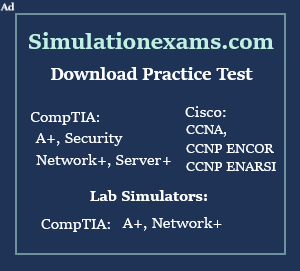7. Transceivers/media converters: Transceivers and media converters are devices that allow different types of cable to be connected to each other. For example, a media converter can be used to convert a fiber optic signal to a copper Ethernet signal, allowing the two cables to be connected. Transceivers are used to convert optical signals to electrical signals, and vice versa.
Explain following Transceiver types
Small form-factor pluggable (SFP) is a type of transceiver used in networking to connect a device to a fiber optic or copper network. It is a compact and hot-swappable module that plugs into a SFP port on a network device. SFPs can support a variety of data rates and transmission distances, ranging from 100 Mbps to 16 Gbps over distances of up to 80 km.
Enhanced form-factor pluggable (SFP+) is an enhanced version of the SFP transceiver. It supports higher data rates, ranging from 8 Gbps to 16 Gbps and can be used for both fiber optic and copper networks.
Quad small form-factor pluggable (QSFP) is a type of transceiver that can support four independent data channels within a single module. QSFPs can support data rates ranging from 40 Gbps to 100 Gbps and can be used for both fiber optic and copper networks.
Enhanced quad small form-factor pluggable (QSFP+) is an enhanced version of the QSFP transceiver that supports data rates up to 100 Gbps and can be used for both fiber optic and copper networks.
Cable management accessories/tools
Cable management accessories and tools help to organize and secure network cables, making it easier to manage and maintain the network infrastructure. Here's a description of each type:
Patch panel/patch bay: A patch panel is a device that is used to terminate cables, organize them, and provide a convenient connection point between the cables. A patch bay is a type of patch panel that is designed to allow the easy connection of different cables, making it possible to easily switch between different devices.
Fiber distribution panel: A fiber distribution panel is a type of patch panel that is specifically designed for use with fiber optic cables. It provides a central point for terminating and organizing fiber optic cables, making it easier to manage and maintain the network infrastructure.
Punchdown block: A punchdown block is a type of connector that is used to terminate twisted-pair cables. The name comes from the process of "punching down" the wires onto the connectors within the block. Punchdown blocks come in different styles, including 66 blocks and 110 blocks.
66/110 blocks: These are types of punchdown blocks that are used to terminate twisted-pair cables. The number in the name refers to the number of pairs of wires that can be terminated on each block.
Krone: The Krone punchdown tool is a type of punchdown tool that is used to terminate wires on a punchdown block. It is designed to be used with Krone-style punchdown blocks.
Bix: The Bix punchdown tool is a type of punchdown tool that is used to terminate wires on a punchdown block. It is designed to be used with Bix-style punchdown blocks.




